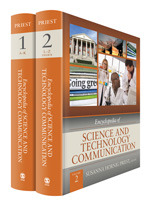Encyclopedia of Science and Technology Communication
- Susanna Hornig Priest - Oregon State University, USA
Topics covered include:
advocacy, policy, and research organizations
environmental and health communication
philosophy of science
media theory and science communication
informal science education
science journalism as a profession
risk communication theory
public understanding of science
pseudo-science in the news
special problems in reporting science and technology
science communication ethics.
".... This highly interdisciplinary set is aimed at an equally broad audience of graduate and undergraduate students in communications, mass media, and journalism as well as postgraduate practitioners.... A nice addition is an appendix that describes academic programs in relevant disciplines including science journalism, science writing, and science communication.... BOTTOM LINE: The staggering diversity of topics covered here will appeal greatly to libraries serving researchers, scientists, journalists, and/or policymakers whose interests span the many disciplines covering science communications. An excellent addition to academic, large public, and special libraries."
"This interdisciplinary resource includes over 300 entries on a wide range of topics related to science communication as both a profession and a research specialization.... Offering perspective on the way nonscientists learn about science-related topics, this is a welcome addition to any academic and large public library, not just those serving journalism and communication students. Also available as an e-book."-BOOKLIST
"Summing Up: Highly recommended. All academic and large public libraries; lower-level undergraduates and above; general readers."

